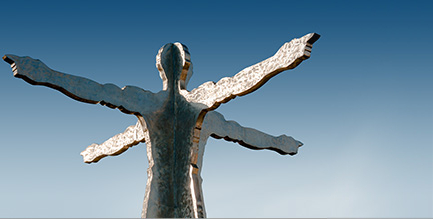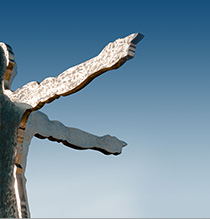In the beginning...
The first traces of people passing through in the Taufkirchen area lead back to neo-politics, that is the time around 2000 BC. This could be proven by the discovery of a ceramic battle ax in Breitenweiher, a village near Taufkirchen (Vils).
The imposing burial mounds at Breitenweiher and Waxenberg date from the Bronze Age (1500 BC).
It is uncertain when Taufkirchen was first settled. However, some signs indicate that people lived here as early as pre-Christian times.
There is evidence of a Roman road that led from Pfaffenhofen near Rosenheim via Haag and Großkatzbach to Weg and then ran via Moosen, Hubenstein, Wambach to Landshut and Regensburg.
The foundation of Taufkirchen (Vils)
A lively settlement of our homeland began in the Bavarian period, as indicated by a number of places that end with "ing". The row graves found in Aham in 1913 also date from this period. The actual foundation of Taufkirchen (Vils) is likely to fall in the 7th and 8th centuries, i.e. in the time of Christianization. A baptistery - certainly wooden - was probably built near the river Vils, which gave its name to a noble family and the later to the town.
At that time Taufkirchen belonged to the old parish of Moosen, which was first mentioned in 769 under Duke Tassilo. During this time Taufkirchen only had the right to baptize. It was not until 1263 that the Taufkirchen church was named as a parish church in a dispute with Moosen.
The noble family of the "de taufkirchen" can be traced back to the 13th century. After 1263 we can no longer find any documentary evidence of the nobles of Taufkirchen.
The castle - Core of development
Taufkirchen Castle is expressly mentioned around 1263 and henceforth forms the core cell from which the town developed. The respective lords of the castle were the landlords and court lords of our homeland and the immediate vicinity. Their property or respective "Hoff" was delimited (= marked) by small, funnel-shaped holes in the ground, which were called "Marchgruben". That is why the property was called Hofmark. Seniors therefore still use the term "Hofmark Taufkirchen" in present times.
From 1377 onwards, the Lords of Fraunberg were the owners of Taufkirchen. In the holy year 1500, many pilgrims also crossed the Taufkirchen area on their trip to Rome, which should be evident from the road map by Erhard Etzlaub from that year.
In 1522 Ladislaus von Fraunberg from the Haag line came into the possession of Taufkirchen. With him the turmoil of the religious division broke over Taufkirchen. In order to raise funds for his brilliant wedding, he sold the Castle and Hofmark in 1554 to the merchant Hans Jakob Fugger for 41,000 guilders.
The time of the Fugger family
From then until 1672 the Counts Fugger ruled in Taufkirchen. They put everything back in good condition and Hans Jakob Fugger had a outer ward (Zwinger) built around the castle, through which one could defend oneself in the event of war. The altar in the castle chapel also bears their coat of arms. In 1609 a "schoolmaster" was mentioned for the first time in Taufkirchen.
Under the Fuggers, Taufkirchen experienced a difficult time, especially during the Thirty Year War. On May 13, 1632, the Swedes invaded Taufkirchen and in 1633 the imperial family was in town. In 1634 the Swedes came again and occupied the area alternately with the French until 1648.
The brewery was built in 1642 during the Fugger rule.
The rule of the Barons of Puech
Due to the repeated warlike events, the property of the Fugger was claimed and the castle had to be foreclosed to the baron Ferdinand von Puech in 1658.
The barons of Puech ruled Taufkirchen as castle owners from 1672 to 1723. Baron Adam von Puech expanded the Hofmark to include Frauenvils, Aham, Schaffhausen, Reckenbach, Eldering, Adlberg, Heldering, Stadl, Wegmann and Kirchlern. Now that Adlberg also belonged to his Hofmark, Adam von Puech relocated the Adlberger Markt to Taufkirchen without further ado. Adam von Puech died childless in 1722. In the following period the ownership of the castle and the associated goods changed quite frequently.
Taufkirchen Castle as an economic factor
For centuries the castle was also the economic center of the town, which is also evident from the two views of Taufkirchen Castle made by copper engraver Wening in 1699. Most of the locals worked as servants, maidservants, day laborers and artisans for the gentry. However, they did not have their own farms and workshops.
Taufkirchen in modern times
In the comprehensive chronicle of Taufkirchen (Vils) compiled by archivist Ludwig Tafelmayer, the year 1848 is particularly mentioned: "In that year serfdom was abolished, trades were able to develop freely and building activity began".
The settlement, which was previously ruled by the castle and its owners, experienced its bourgeois hour of birth and the beginning of an economic boom during this period.
Here are some historical notes:
- The first post office was built in 1847.
- Taufkirchen owned a magnificent church with an octagonal structure and rich furnishings until 1890. That year it was destructed. Today's parish church, which was built in 1893 on the same spot.
- Another milestone was reached on December 24, 1898 with the opening of the train connection from Dorfen via Taufkirchen (Vils) to Velden.
- Until the end of the 19th century, it is known that Taufkirchen still had thatched houses.
- There used to be two customs offices in the village, one of them with a drop gate.
- In 1910 the old gothic salt barn - also known as the dance house - that stood on the market square was demolished.
- On July 19, 1917, citizens of Taufkirchen founded a cooperative and bought the castle with 800 days of land and the brewery. The cooperative continued to operate the brewery and 180 Tagwerk (151.55 Acres), while the rest of the land was sold to farmers and citizens.
- In 1919, the state poor association bought the castle with outbuildings and 200 Tagwerk (168.39 Acres) of land with the aim of building an institution for people in need of care. On December 5, 1919, the west wing of the palace burned down.
- Local households were supplied with electricity for the first time in 1919, and 13 years later work began on expanding the water pipes.
Economic boom after the Second World War
In 1939 Taufkirchen (Vils) with 1,765 inhabitants was still a place of little importance in the district. That changed after the Second World War. Many businesses were founded, including a weaving mill, a wheat beer brewery, a sausage factory and a shoe factory. These activities were supported by a strong influx of displaced persons. Above all the establishment of the Himolla upholstered furniture factory, led to an unexpected economic upturn. The population figures also made this clear: in 1970 more than 5,000 inhabitants were registered.
The town owes a large part of its economic boom in the second half of the last century and its development to a sub-center for the region to the factory founder and honorary citizen of Taufkirchen, Carl Hierl.
The Taufkirchen municipal coat of arms
![[Translate to English:] Wappen von Taufkirchen](/fileadmin/Bilder/MarktGemeinde/Gemeinde/Geschichte/Wappen.gif)
A silver chapel in Romanesque architectural style on a blue background dominates the coat of arms of Taufkirchen (Vils). The upper part, the so-called shield head, is red, the pole in the middle is silver.
The two distinctive parts of the coat of arms refer to the early importance of the river crossing over the river Vils. The Romanesque baptistery is reproduced very well in the coat of arms. The image as a noble, well-formed Romanesque round building clearly shows the grandeur of its architecture. The baptismal font must have had a considerable importance in the Vils Valley. According to historical records, the chapel was preserved until 1890.
The upper part, the silver pole on a red background, symbolizes the family coat of arms of the Fraunbergers, who were lords of the castle and its surroundings in Taufkirchen (Vils) before 1300 and then again from 1486 to 1554. Connections can be clearly seen here with the family coat of arms of the "Taufkirchner zu Gutenburg". As early as the twelfth century, reports were found of a noble family "Taufkirchen". They probably performed control tasks at the most important monitoring point over the Vils.
The Bavarian State Ministry of the Interior approved the adoption of the coat of arms on March 8, 1954. Design of the coat of arms: Emil Werz, Munich.
Town Hall Archives
The history of Taufkirchen presented here is only an overview of the most important historical events. It is an extract from a comprehensive chronicle by Ludwig Tafelmayer. It was also he who meticulously put together a unique collection of historical testimonies until his death in 2007. The archive was then maintained by Hans Jell, who died in 2019.
Since then, Tobias Karbaumer has been taking care of the historical documents of Taufkirchen as an archivist. He can be reached on 0175 3347781 or email: tobiaskarbaumer(at)gmx.de. More informations on Town Hall Archives.



![[Translate to English:] Wasserschloss Taufkirchen](/fileadmin/_processed_/5/3/csm_Schloss_01_dc9645ae6e.jpg)